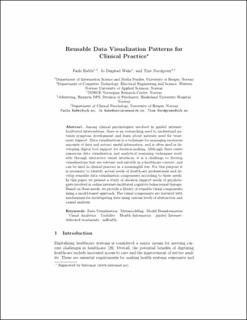Reusable data visualization patterns for clinical practice
Chapter
Accepted version

Åpne
Permanent lenke
https://hdl.handle.net/11250/2723181Utgivelsesdato
2020Metadata
Vis full innførselSamlinger
Originalversjon
Rabbi, F., Wake, J. D., & Nordgreen, T. (2020). Reusable Data Visualization Patterns for Clinical Practice. In Ö. Babur, J. Denil, & B. Vogel-Heuser (Eds.), Systems Modelling and Management (pp. 55–72). Springer International Publishing. 10.1007/978-3-030-58167-1_5Sammendrag
Among clinical psychologists involved in guided internet-facilitated interventions, there is an overarching need to understand patients symptom development and learn about patients need for treatment support. Data visualizations is a technique for managing enormous amounts of data and extract useful information, and is often used in developing digital tool support for decision-making. Although there exists numerous data visualisation and analytical reasoning techniques available through interactive visual interfaces, it is a challenge to develop visualizations that are relevant and suitable in a healthcare context, and can be used in clinical practice in a meaningful way. For this purpose it is necessary to identify actual needs of healthcare professionals and develop reusable data visualization components according to these needs. In this paper we present a study of decision support needs of psychologists involved in online internet-facilitated cognitive behavioural therapy. Based on these needs, we provide a library of reusable visual components using a model-based approach. The visual components are featured with mechanisms for investigating data using various levels of abstraction and causal analysis.
Beskrivelse
This is an author's accepted manuscript version (postprint) of an article published by Springer. The final authenticated version is available online at https://doi.org/10.1007/978-3-030-58167-1_5